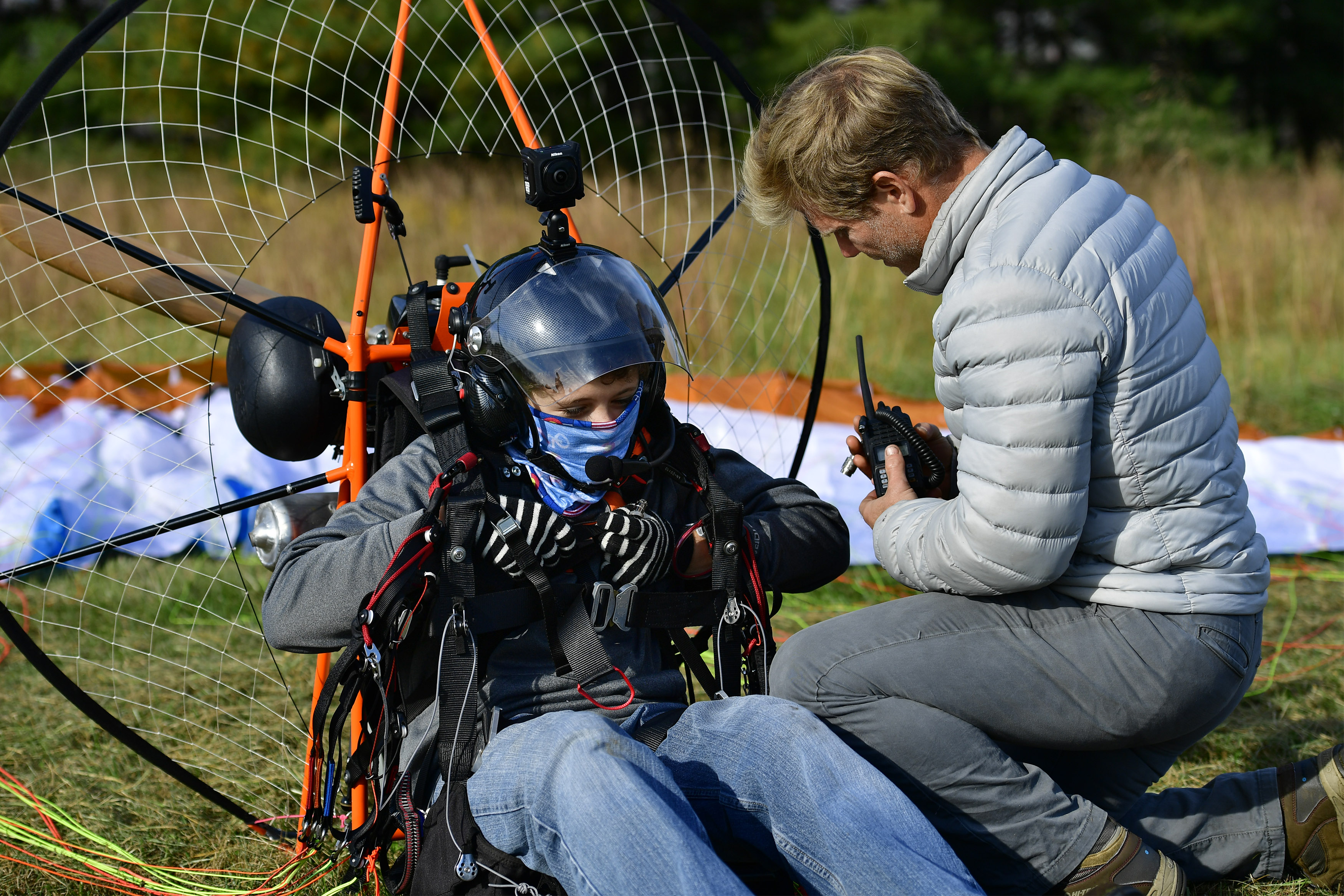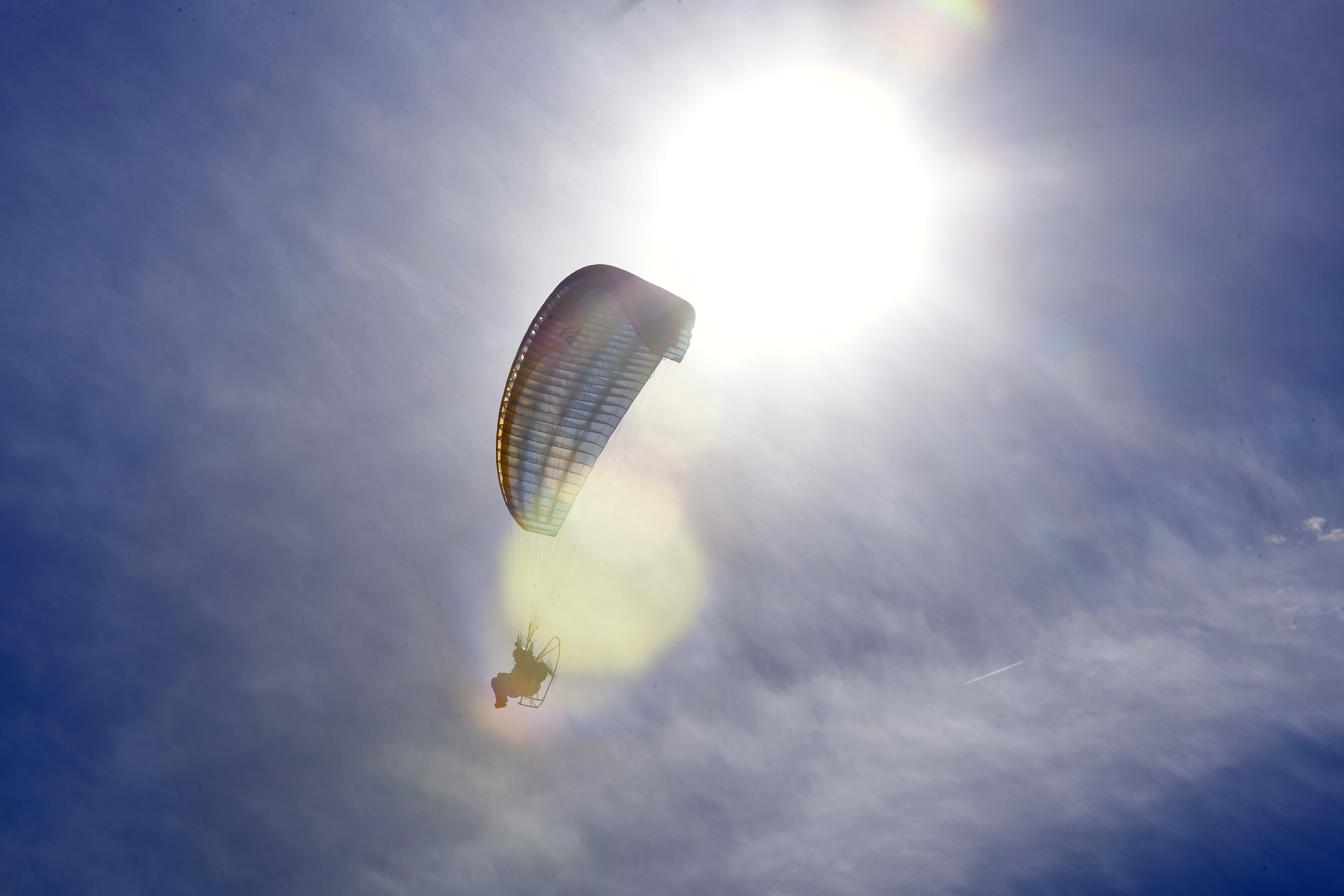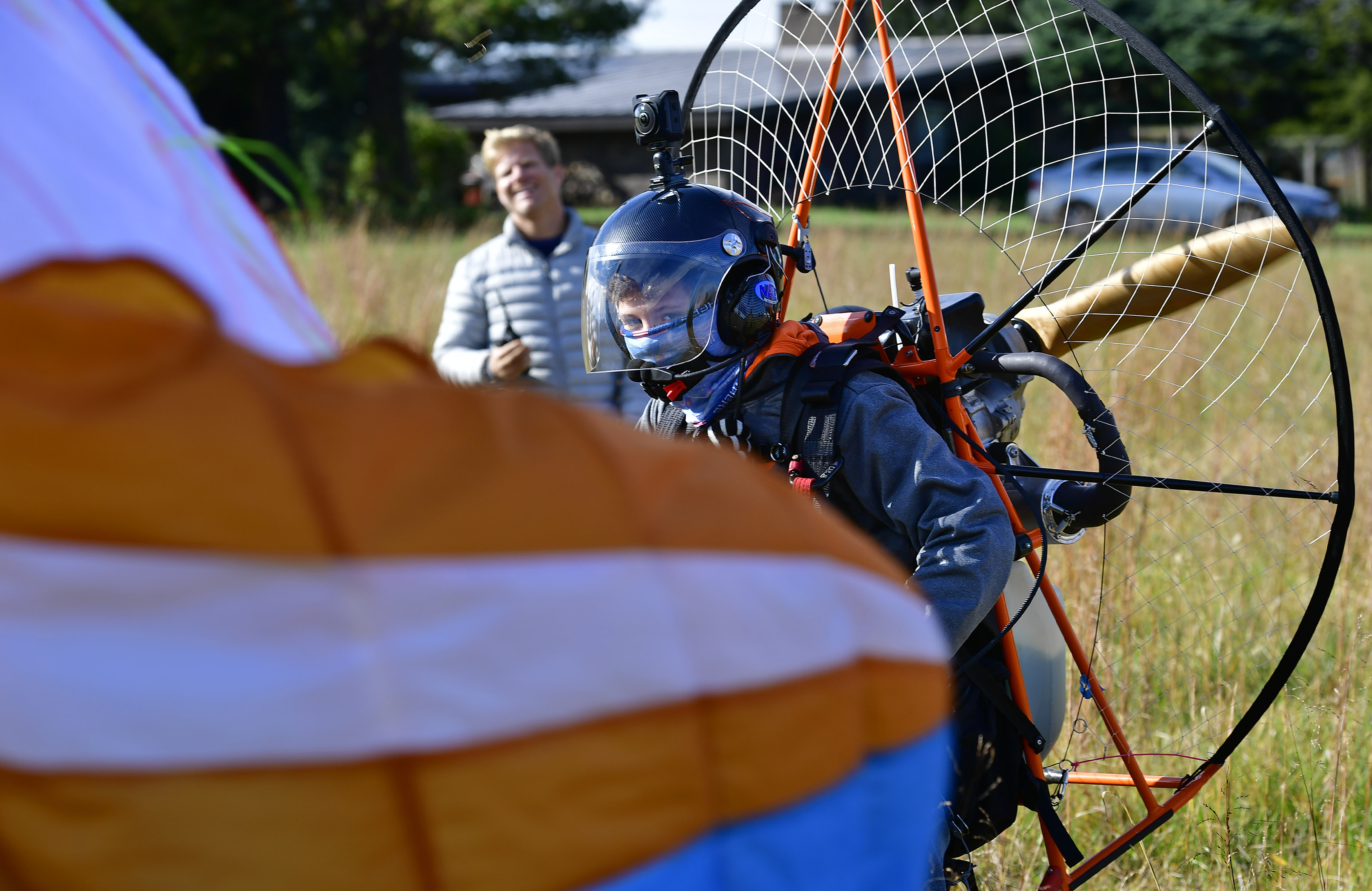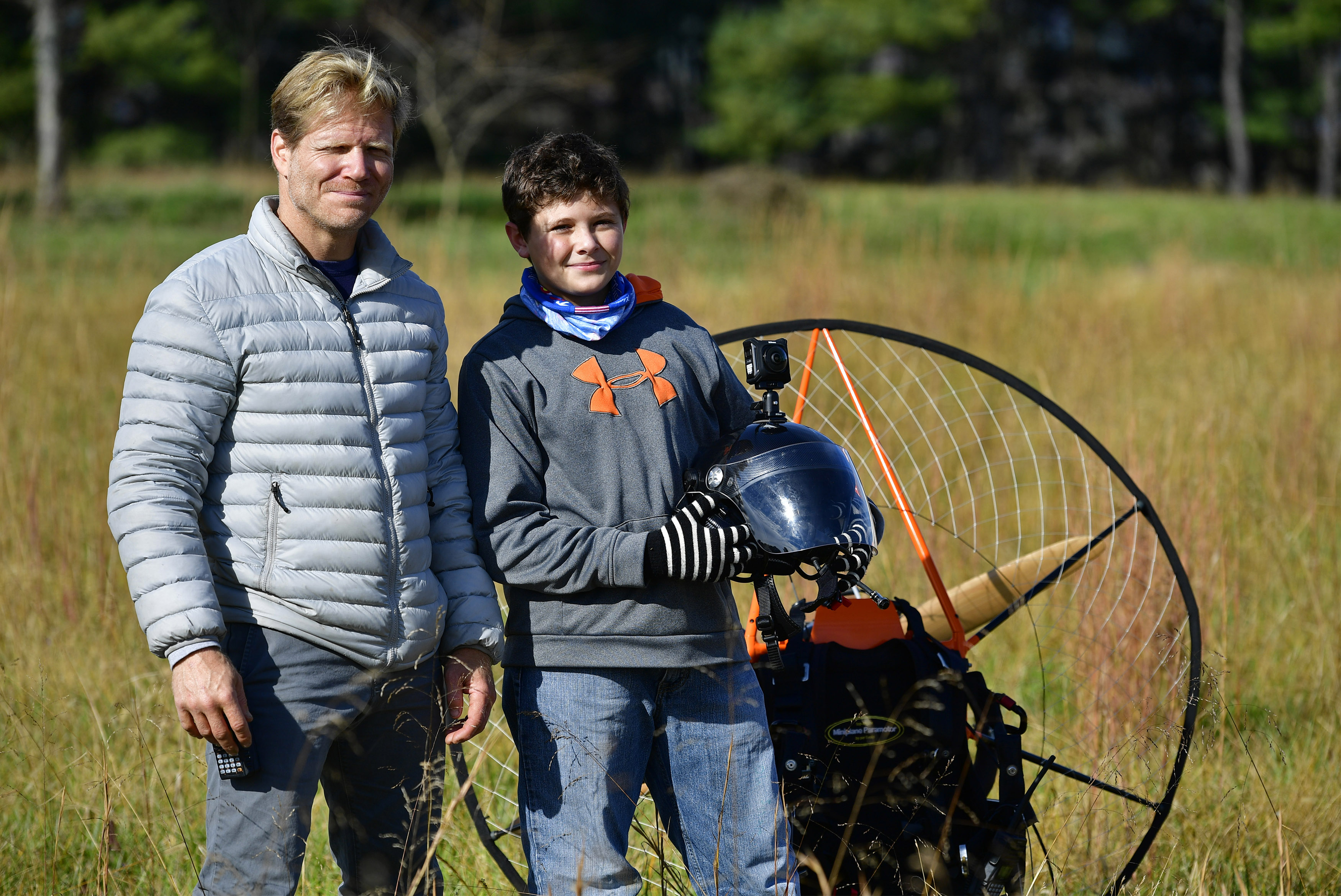All in the family: Dad teaches son to fly
Middle schooler earns powered paraglider rating
Radio in hand, Jens Scott coached his middle-school-aged son Henry in for a two-point landing as the youth broke into a trot, his blue-and-orange powered paraglider parachute billowing out behind him under the cobalt sky.
The father-and-son duo practiced together for weeks, first on a ball field with just the parachute and ropes, as Scott ran in front and bodily towed his child into the air one inch at a time. The younger Scott was eager to follow in the footsteps of his helicopter- and multiengine-rated father. He did strength training exercises to shoulder the 45-pound two-stroke motor and propeller, took lessons from powered paraglider instructor Michael O'Daniel, and practiced kiting—a precursor to powered flight.
“Before he had an engine, I would tow him with a rope” and run fast enough to launch him. “That gave him some time in the air to control the wing.” He added that it was easier to fly the wing than it is to handle it on the ground. “Once you’re in the air, it’s a piece of cake.”

The youth got better at physical inputs while he learned additional control maneuvers. “He got to a point where he was pretty good and he’d make motor noises with his mouth and that would signify to us a successful takeoff.”
Control inputs to the wing are similar to a flaperon, Scott explained. “The entire trailing edge is deflected downward so it slows the whole wing down on that side and then you veer in that direction.”
Henry soloed the powered paraglider shortly after his twelfth birthday (he turned 13 on March 13) and gradually built up flight time through solo cross-country trips while he earned his U.S. Powered Paragliding Association PPG2 rating. Students and pilots pursuing powered paragliding ratings levels one through three must be supervised by a powergliding instructor and pass all of the required tests, which build upon each other.
“As you might imagine, I'm very proud of Henry's accomplishment,” said Scott, who added that his son began accompanying him in the family’s Mooney “since he was about zero” years old. “When he was about two, I told him to look at the GPS and play it like a video game to keep us on the magenta line.”
The entire family attended EAA AirVenture several times, “and he always wanted to be the pilot, not just the copilot.”

Scott explained that a powered paraglider was “as close to a bird as any human can be. It’s the most minimal form of flying—it’s just your ‘Fred Flintstone’ feet,” a thin sheet of fabric, some ropes, a small engine, and skill. “When you run, the parachute wing foil fills with air and takes shape above your head.” He explained that pilots manipulate the brake handles in their left and right hands and when they apply throttle to the two-stroke engine, “all of a sudden, your feet are above the ground. Then you pull your feet up and you’re flying!” he exclaimed.
Henry’s first flight “was kind of an amazing sight for me,” recalled the father. “Imagine seeing your 12-year-old son going up, up, and then over the trees—and there he goes.”
A complete flying rig costs $6,000 to $15,000, travels at 20 to 40 mph, and has one to three hours of endurance, according to the paragliding association.

Scott noted that he wasn’t worried about Henry getting lost because the powered paraglider rig is “pretty slow. It tops out at about 20 knots and if you’re in a headwind, then things can get really slow. You could probably bicycle somewhere quicker.” When the youngster flies, the two keep in touch with handheld radios and he wears a helmet and other protective gear. Scott is either nearby or within earshot on the radio.
When asked about the inevitability of gravity, Scott said he wasn’t worried. “With a powered parachute, Henry could just let go, float down, and crash into whatever he landed into—and it probably wouldn’t be much worse than falling from a bicycle.”
They’ve flown a few cross-country trips in a Cessna 150 to identify a potential powered paragliding route by visual references only. “He can identify those same landmarks—water towers, railroad tracks, roads, and the Home Depot—and then fly it in the parachute,” Scott noted. Since he’s been flying solo, Henry has learned about airspace and where he can—and can’t—be.
“He has to stay in Class G and Class E airspace, similar to the rules for an ultralight,” added Scott. “I follow him on the ground and we plan the course to stay out of other airspace.” The family lives on the western side of the Washington, D.C. Special Flight Rules Area, so there are practical challenges to every local flight. Scott has resisted the idea of getting his son a GPS because he wants the youth to fly by pilotage. “I tell him, ‘Henry, the sun is going to be on your right and the mountains are on your left.’ I give him a good idea of where the SFRA starts so he can steer clear of it.”

Henry chose to pursue powered paragliding when he was 11, and now that he’s mastered the technique he would like to step up to an FAA Part 103 ultralight aircraft with wings, a fuselage, and man-made landing gear replacing jeans and sneakers. Scott made a deal with his son that included Henry getting straight As on all of his report cards before he could move up to a larger aircraft. So far that hasn’t happened, Scott confided, but he’s hopeful that it will.
We joined the pair to observe a flight on a brisk fall morning from Thomas Pomeroy’s private grass strip in Lovettsville, Virginia. The father-and-son team worked in tandem to survey the wind, then they carefully spread out the parachute and harness lines.
Together, they preflighted the mechanical components and held a briefing to review procedures. Scott started the engine for his son, ran clear, and watched as air filled the foil and launched his child above onlookers, pastures, and the foothills of the Appalachians. Wispy clouds streaked high above the airfield under a bright sun.

When it was time to land, Scott encouraged, guided, and reminded his son of the procedures they worked onto ensure a smooth landing. After a successful touchdown, the two shared a pair of million-watt smiles that came from the satisfaction of conquering something together.
As Father’s Day approached, Scott said that the family was again making plans to attend EAA AirVenture. This time, Henry has an appointment with an Oshkosh, Wisconsin-based powered paragliding instructor, and the two are hopeful the young aviator will be cleared to fly at the airshow above thousands celebrating all forms of aviation.












